New This Week:
Prices in U.S. Dollars are listed in GREEN.
 |
 |
 |
| box | closed |
 |
 |
| card | eagle |
 |
 |
| engraver | inner bowl |
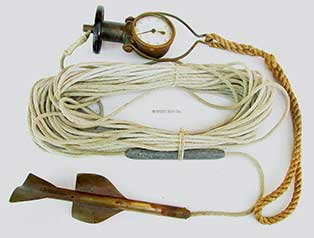 |
|
3.69 EARLY AMERICAN TAFFRAIL LOG. Genuine 19th century ship’s taffrail log set made by the noted American nautical instrument makers “NEGUS PATENT LOG” as denoted on the register dial and stamped “NEGUS” on the spinner. This handsome set is totally complete with the register, its braided attachment line, lead sinker, the very long cotton line and the spinner (also known as the “fish”). Also included, but not shown on the accompanying literature, is a second heavy sinker for use in heavy seas. The petite brass-cased dial of this precision instrument is hard-fired porcelain with two indicator dials. The larger dial on the periphery is calibrated in nautical miles 0 - 50. The subsidiary dial is marked in “TENTHS” of a mile. The body of the register is solid brass with a pivoting yoke on one end secured to the vessel. The bottom has a thick solid brass rotating brass governor. To it is attached the cotton long line leading to the fish. The attachment is warped in a seamanlike manner. All components, including the line are in excellent original condition, showing actual careful use. Of special interest regarding value and desirability is the fact that this offering comes complete with its rarely found original box and instructions. The unprotected cardboard box, usually deteriorated during normal use in the harsh marine environment, is still present here! It has the decorative label reading “NEGUS PATENT LOG” with an image of the set. In addition, the original VERY fragile instructions, although incomplete, are preserved within a plastic sleeve. 10 inches long by 4 inches high and 4 inches wide. A truly remarkable nautical survivor of American maritime history well over 100 years old! Now offered at an unheard of reduced price to sell in these inflationary times! How much did dinner out cost? How much is gold? WAS $595 NOW! 295 |
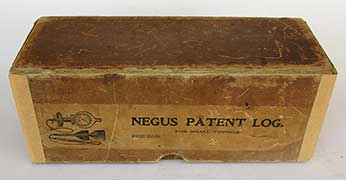 |
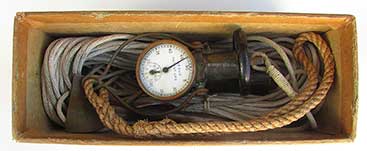 |
| box | in box |
 |
 |
| fish | register |
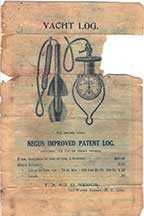 |
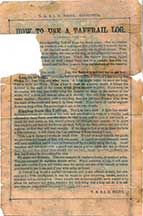 |
| instructions | instructions back |
 |
|
13.36 EARLY FRENCH CHRONOMETER. Offered here is a magnificent French ship’s chronometer well over 100 years old! Chronometers for French ships are scarce in today’s market, dominated by English and American examples. This precision timepiece has a perfect silvered brass dial beautifully hand-engraved “A. Masselin No. 156 Nantes, St. Nazaire.” It is boldly marked with Roman numerals and a minute chapter ring swept by SOLID GOLD spade hands! The subsidiary seconds bit below the center arbor is calibrated in single seconds marked by 10’s. The Up/Down winding indicator is below the XII. It runs from 0 to 56 hours and is marked “BAS/HAUT.” The 4 ½ inch dial is protected by its knurled brass bezel with a thick beveled glass crystal and silvered reflector ring. The chronometer is set in its original brass bowl with original lacquer finish. The bottom of the bowl has a rotating dust cover over the internal winding square. Unscrewing the bezel reveals the finest quality movement within. It has highly polished brass plates with contrasting blued steel screws. The heavy duty compensated bi-metallic balance with early style steel helical hairspring and diamond end stone has a spring detent escapement and of course a traditional chain-drive fusee. The bowl is slung in its stout gimbal ring with locking lever, all mounted in its very rich Coromandel wooden box with brass string inlays.* It has a lovely circular mother-of-pearl inlay in the upper tier. The box is complete with it folding inlaid brass handles on both sides and its original functional skeleton lock and key! It bears the old trade label of “E. BRASSEUR, Horologer de la Marine, Le Havre” dated 1927. The box measures 7 ¼ inches square and is 6 ¾ inches high. It is complete with its original brass ratcheted winding key. Overall condition is EXCELLENT in all respects. The chronometer is in good running condition, and keeps good time. Absolutely guaranteed to be as represented, or your money back. A $3900 VALUE NOW! 1495 A genuine Best Buy! |
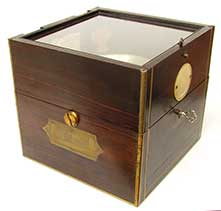 |
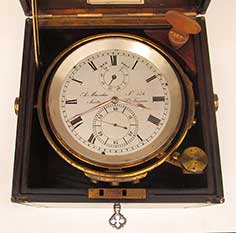 |
| perspective | in box |
 |
 |
| dial | front |
 |
 |
| movement 1 | movement 2 |
 |
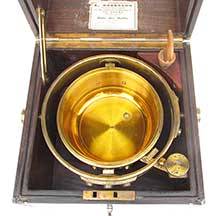 |
| label & key | bowl |

|
18.77 HUGE SHIP’s MASTHEAD LAMP. Very impressive all copper and brass German ship’s masthead lamp from the turn-of-the-last-century. This extra large ocean-going navigational light retains its beautiful molded Fresnel glass lens marked with 3 “G”s within a triangle. The top front of the lamp bears the embossed brass tag reading “TOPLICHT.” The lamp body is made of heavy riveted copper. There are 4 cast brass brackets, 2 on each side, which supported the lamp on rods affixed to the top of the ship’s superstructure or mast. A large copper bail handle is attached to the top for carrying. That top is also equipped with a hinged, castellated chimney cap to disperse heat and to provide an opening from which to inspect the burner within. To those ends the lamp is complete with a large copper oil sump (font) mounted on a slide-in tray. The sump has a threaded brass oil filler cap and a support for its parabolic reflector. The complex burner is of the finest typed with dual wicks, dual wick advance knobs and built-in snuffer. It is complete with its beautiful and original crystal chimney marked “ANCHOR BRAND FIRE PROOF” with anchor emblem. Access is gained through the back by means of the hinged copper door with sliding pin closure. This massive old ship’s lantern stands 21 ¼ inches tall exclusive of the bail handle, 12 ¾ inches wide at the widest by 10 ½ inches deep and weighs an impressive 16 pounds! Outstanding condition with no dents, dings or losses and a lovely old age patina. The Freznel lens is perfect. 895 |

|
18.61 FIGURAL TABLE LAMPS. Matched pair of 19th century American portable table lamps. These all brass oil lamps have a circular base supporting a bulbous brass column on which is mounted the oil font with burner and chimney holder. The circular wick advance knobs are signed “STERN BRO’S N.Y.” and “THE P.&A. MFG Co VICTOR” respectively. What makes these lamps really outstanding are their figural brass dolphin handles. They stand 9 inches tall and 5 ½ inches in diameter at the base, 6 inches wide overall. Excellent original condition showing expected signs of use and a nice statuary bronze age patina. Circa 1875. 895/pr |
burner detail |
handle |
makers |
bottom |

|
22.24 “MOUNTAIN” BAROMETER. Quite scarce early 1900’s American “Mountain Barometer” with the unique feature of being adjustable for altitude (elevation). This precision instrument was made by the Tycos Company of Rochester, N.Y. as signed on the bottom of the white enameled dial. The dial is calibrated for atmospheric pressure in inches of mercury spanning the wide range from 25 to 31 inches in 2/100th increments marked by 10’s. It bears the standard weather indications “@STORMY @ RAIN, CHANGE * FAIR @ VERY DRY @” with the added notations “LOW & HIGH.” At the top it is marked “PAT. AUG.-18-1914.” The reading is indicated by a fine blued steel needle overlaid by a brass “set needle” with knurled brass knob rove through the beveled glass cover. The body of this instrument is solid bronze in its original flawless golden lacquer finish. The back of this instrument bears the rare patented feature which allows it to be adjustable. It consists of a knurled disc calibrated in feet of elevation from 0 to 3,500. The engraved instructions read, “FOR A SEA LEVEL READING ROTATE THIS PLATE UNTIL THE ARROW ON THE CASE POINTS TO THE ALTITUDE OF YOUR LOCALITY.” The back also has an aperture for a set screw to further adjust the movement. The top is equipped with a pivoting brass loop for hanging. 5 ¼ inches in diameter and 6 inches high overall. Absolutely perfect condition is all respects. The precise mechanism is lively and accurate. The best! 395 |
perspective |
dial |
back |

|
AUTHENTIC LIGHTHOUSE. The ultimate! This was an exceptional opportunity to own a very historic relic of America’s rich maritime heritage embodied in the original lamp room from the famous Ballast Point Lighthouse, which served its sentinel duties in the channel of San Diego Bay from 1890 until 1960. This incredibly well-preserved piece of history was built according to specifications laid out by the U.S. Lighthouse Service in 1885. A copy of the original specifications are included as are much printed references and photographs. Erected in 1890, the 5th Order lighthouse was a significant aid to navigation in conjunction with the Point Loma Lighthouse (1850) poised at the entrance to San Diego Bay. Ballast Point Light was situated further inside the massive bay on a point which jutted into the seaway which posed a hazard to shipping. 135 years old! SOLD HISTORY On October 2, 1888, recognizing the need for a harbor light in the increasingly congested channel of San Diego Bay, Congress authorized $25,000 for the construction of a lighthouse to be built on Ballast Point. Fashioned in the late Victorian style, the entire structure took 3 months to build beginning in March 1890. The light was first lit on August 1st. It was a sister of the lights at San Luis Obispo and Table Bluff, south of Humboldt Bay. All were wood framed structures with attached living quarters. The ironwork for the lantern was forged in San Francisco and carried south to San Diego by ship. The French firm of Sautter, Lemmonier, & Cie. manufactured the Freznel lens for the Ballast Point Light in 1886. The fixed 5th Order lens was visible for a distance of at least 11 miles. When California was still part of Mexico the peninsula jutting into San Diego Bay was known as Punta del los Guijarros or “Pebble Point.” For centuries cobblestones washed down by the San Diego River had been deposited on the point. When California gained statehood in 1850 the point was renamed Middle Ground Shoal. As time went on and merchant traffic in the harbor increased, many sailing ships found it convenient to load or discharge the stones as ballast. The practice continued and eventually the name “Ballast Point” stuck. Accompanying the Ballast Point lighthouse was a huge 2,000 pound fog bell in a wooden tower. In 1928 it was supplanted by a single tone electric diaphone horn. The first keeper of the light was John M. Nilsson, assigned duty on July 15, 1890. The second was Henry Hall, who took the job on December 1, 1892. Perhaps the most famous keeper was Irish born David R. Splaine, a Civil War veteran and veteran lighthouse keeper, who assumed the post in 1894, having served at Point Conception, the Farallons and San Diego’s own Point Loma light from 1886-1889. In 1913 the original old kerosene lamp was replaced with an acetylene burner. Acetylene gave way to electricity in 1928. In 1938 a filter was fitted inside the 5th Order Freznel lens giving the light a distinctive green hue for recognition. One of the last keepers of the light was Radford Franke who recalled receiving the order to “douse the light” upon the news of the attack on Pearl Harbor. By early 1960 the light was deemed to be of no further service, so in June of that year the lantern room was removed to a salvage yard. The wooden tower and its brick and mortar foundation remained a couple of years later until they too were declared structurally unsafe and demolished. The bell tower continued to survive, mounted with a 375 mm high intensity lamp on its roof. However the value of maintaining any light on Ballast Point diminished with the installation of harbor entrance range lights. In the late 1960’s the bell and its tower were dismantled. The tower found its way to a private residence in Lakeside, California. The bell had a more circuitous later life. It was purchased from a San Diego area junk yard in 1969 for its scrap value of 5 cents per pound! The one ton bell remained on local private property until 1991, when it was put on loan to the San Diego Maritime Museum. In 1999 the bell was transported to the son of the original buyer, living in Colorado. Then in 2002, the bell finally found its way to the home of the owner’s granddaughter living in Vermont, where it rests to this day. The story of the lantern’s later life is even more fascinating. The nation was just recovering from the Cuban Missile Crisis between JFK and Khrushchev, when in 1964 the Cuban government cut off the fresh water supply to the U.S. Naval base at Guantanamo Bay. By that time, an experimental desalinization plant had been in operation at Point Loma for 2 years. The Navy hastily ordered it to be disassembled and shipped through the Panama Canal to Cuba. A gentleman working as a crane operator during the process noted the shabby lantern room in a trash heap nearby. He inquired as to the fate of the relic and was told it was salvage. Asking if he could purchase it, the yard foreman told him he could “have it” if he would haul it away. With that, for the next 34 years the lantern room served as a gazebo in the backyard of the man’s residence in Bonita, California. It was purchased by the present owners in 1998, fully refurbished, and then placed on public display ever since. Now it is time for it to find its next new home. According to the crane operator who delivered the lamp room it weighs approximately 5 tons. It will require a crane and a flat bed truck for removal. BIBLIOGRAPHY F. Ross Holland, “The Old Point Loma Lighthouse,” 1978, Cabrillo Historical Association, San Diego, California Jim Gibbs, “The Twilight of Lighthouses,” 1996, Schiffer Publishing, Atglen, PA. Kin Fahlen and Karen Scanlon, “Lighthouse of San Diego,” 2008, Arcadia Publishing, San Francisco Kraig Anderson, “Forgotten Ballast Point “Lighthouse” Seeks New Home,” article in “Lighthouse Digest,” East Machias, Maine, September – October 2011, Vol. XX, no. 5 pages 34 – 37. “Mains’l Haul,” a periodic publication of the San Diego Maritime Association, Summer 1990, Vol. XXVI, No. 4, pp. 11-12. |
 |
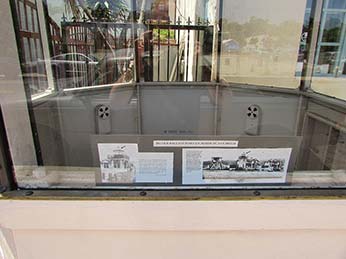 |
| LIGHTHOUSE BACK | DETAIL BRASS WINDOW MOLDINGS AND GLASS |
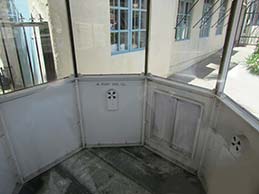 |
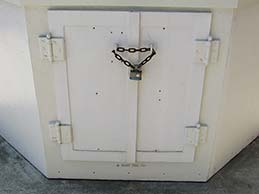 |
| INTERIOR | ENTRY DOORS. THERE WAS NO INTERNAL ACCESS TO THE LAMP ROOM |
 |
 |
| THE LIGHTHOUSE COMPLEX AS IT APPEARED IN THE 1940'S | DISMANTLING THE LANTERN ROOM IN 1960 |
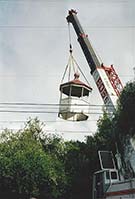 |
| LIGHTHOUSE GINGERLY BEING REMOVED OVER HIGH TENSION POWER LINES |









































